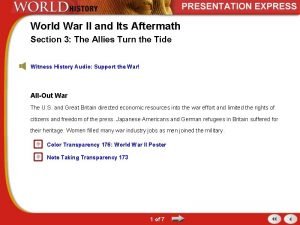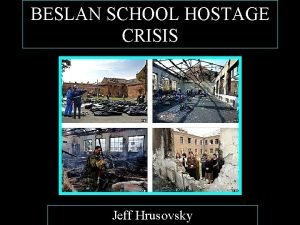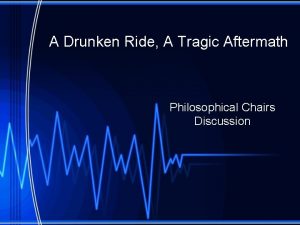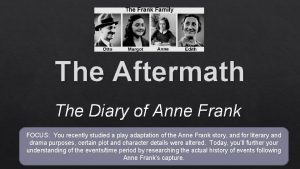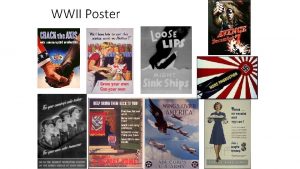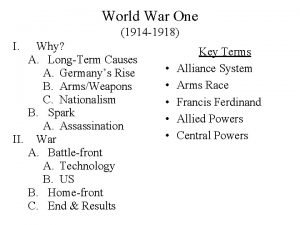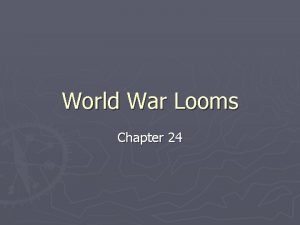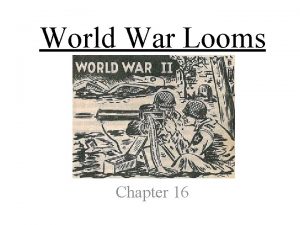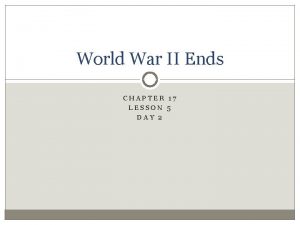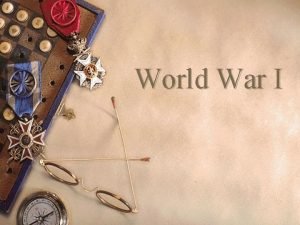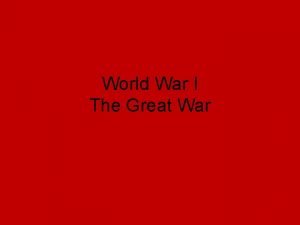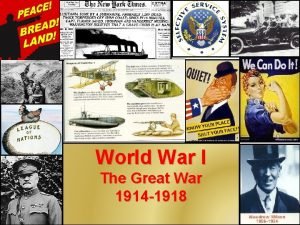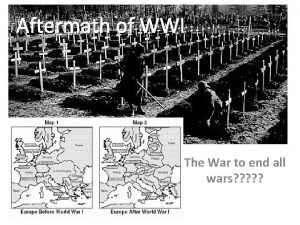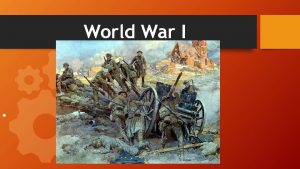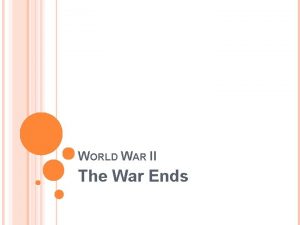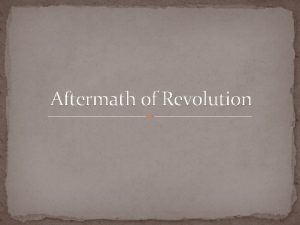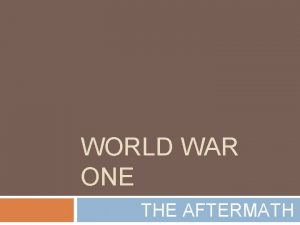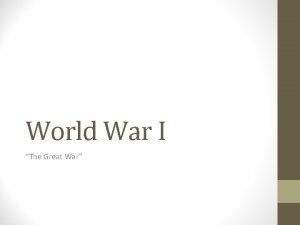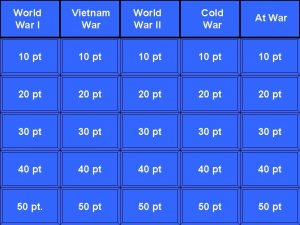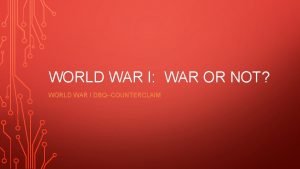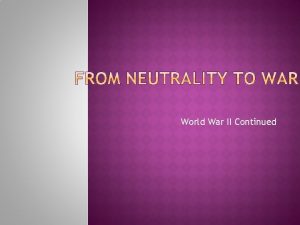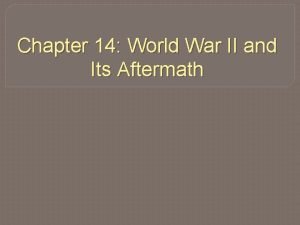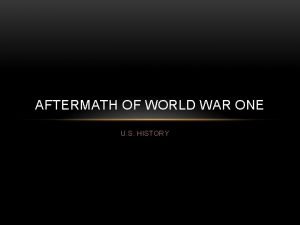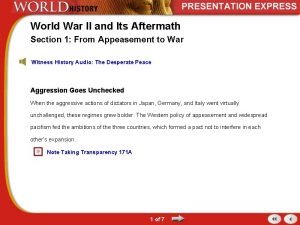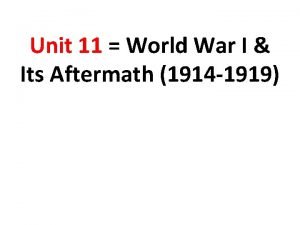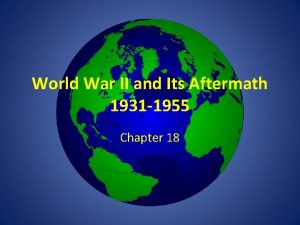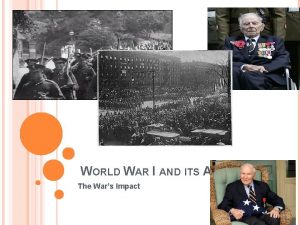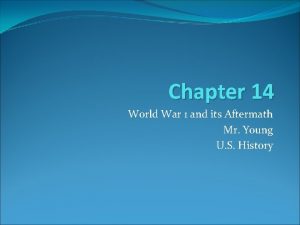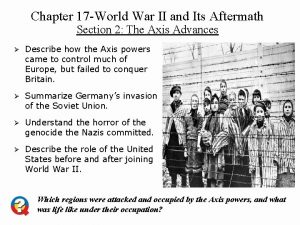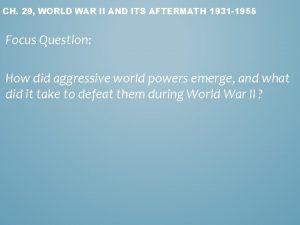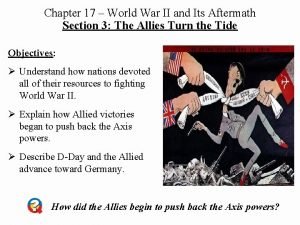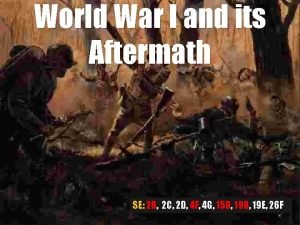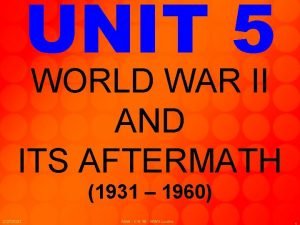The Aftermath of World War II Following World





































































- Slides: 69

The Aftermath of World War II Following World War II, the U. S. and Soviet Union embraced in a chilling diplomatic standoff that fundamentally changed the world.

SOLs 14. What was the purpose of the Geneva Convention? 15 Define Cold War 16. What was the Marshall Plan? 17. Describe the Berlin Airlift. 18. East Germany was ____ & backed by _____. West Germany was ____ & backed by _____. 19. Who did the U. S. support in China during the Cold War? 20. What “Policy” forced the U. S. into the Korean War? 21. What was the outcome of the Korean War?

British Prime Minister Winston Churchill, along with U. S. President Franklin Roosevelt and Soviet Leader Joseph Stalin, attend the conference at Yalta. February 1945.

The Geneva Convention • Mandated humane treatment of P. O. W. s. • The Bataan Death March: U. S. P. O. W. s suffered brutal treatment by Japanese. • The treatment of prisoners often reflect the values of a Nation.


June 26, 1945 United Nations is formed. To prevent future Global Wars. Replaced the League of Nations.

The Early Cold War: 1947 -1970

1948 Israel After W. W. II Israel is created as a homeland for the Jewish People. .

Cold War: War of words…without actual fighting- between the U. S. & the U. S. S. R. Differences led to Conflict… How and why did the Cold War begin?

The U. S. and the U. S. S. R. emerged from W. W. II as SUPER POWERS! The Soviet was United. Union States was democratic and capitalist. Totalitarian and Communist.

DEMOCRACY The Causes of The Cold War Were - Different Political Ideologies - The Soviet domination of East Europe - U. S. policy of containment - NATO vs. Warsaw Pact military rivalry COMMUNISM

Map of Former U. S. S. R.

Warsaw Pact (1955) } } U. S. S. R. Albania Bulgaria Czechoslovakia } } East Germany Hungary Poland Rumania

North Atlantic Treaty Organization (1949) v United States v Luxemburg v Belgium v Netherlands v Britain v Norway v Canada v Portugal v Denmark v 1952: Greece & v France v Iceland v Italy Turkey v 1955: West Germany v 1983: Spain

More Differences The U. S. economy experienced a period of growth and prosperity after World War II. The Great Depression was over. Meanwhile the Soviet economy struggled as they tried to rebuild their war-torn country.

Former Allies Become Enemies! Winston Churchill declared that an "iron curtain" had descended on Europe, dividing it into two halves!

We Must Contain Communism! Gave Greece & Turkey $400 million in aid prevent Communist takeovers in Europe

Rebuilding efforts The United States planned to rebuild European economies and prevent the spread of communism.

Much of Europe was in ruins following World War II… The United States felt it was in its best interest to rebuild Europe and prevent political and economic instability.


The Post-War Struggle for Power Continues!

Germany was partitioned into East and West Germany became democratic and resumed self-government after a few years of American, British, and French occupation. East Germany remained under the domination of the Soviet Union and did not adopt democratic institutions.

Berlin Blockade & Airlift: In 1948, the Soviet Union blocked all road and rail access to West Berlin. The Berlin Airlift marked a rise in tensions between the West and the Soviets; however, it avoided armed conflict.

The Berlin Wall Goes Up (1961) In this Oct. 7, 1961 file photo, a West Berlin guard stands in front of the concrete wall dividing East and West Berlin at Bernauer Strasse. (AP Photo, File) Checkpoint Charlie

In 1961 the East German government closed the border between East and West Berlin and built The Berlin Wall. East Germany behind the Berlin Wall

Berlin's historic Brandenburg Gate in late November was put behind part of the wall erected by the East German regime to separate East Berlin, left, and West Berlin shown Dec. 2, 1961. (AP Photo) T h e w a l l b e c a m e a s y m b o l o f t h e COLD WAR t h a t existed between communism and democracy.

Cold War in China • Communist leader Mao Zedong defeated the forces of General Chiang Kai-shek. • The Cold War intensified Americans' fears of communism. • Containment fails in China

Kim Il-Sung The Korean War: A “Police Action” (1950 -1953) The Soviets test the Atomic Bomb. Bad news for the U. S. ! Syngman Rhee

Korean War

KOREA • The truce line was set at the 38 th parallel. • The line, although invisible, was every bit as divisively symbolic as the Berlin Wall.


38 th Parallel Cold War in Korea • Containment lead to U. S. involvement in Korea in the 1950 s. After two years of fighting a cease-fire was finally reached. • Communist North invaded South Neither side achieved victory. Korea or gained much territory. It ended in a stalemate. Korea. • South Korea and the United States resisted Chinese and North Korean aggression.

• President Truman insisted on confining the fight to Korea. The supreme commander in the Far East, Gen. Douglas Mac. Arthur, and others wanted to strike directly at China in an effort to win a quick victory. On April 11 Truman fired Mac. Arthur.

Early Cold War 1. _____ & _____ were Super Powers after W. W. II 2. _____ was the peace keeping ageny created after W. W. II. 3. What leader blocked entrance into Berlin in 1948? 4. Military Alliance formed by the U. S and its’ allies… 5. What document said we must contain Communism? 6. America’s plan to rebuild Europe was called the ___ 7. West Germany was backed by ____. 8. In 1961 the Communist built ___ to separate Berlin. 9. Mao Ze. Dong was the communist leader of _____. 10. What 2 areas were divided at the 38 th parallel?


Domino Theory if one country falls to Communism others in Asia may soon follow.

What about Japan? § Adopted a democratic form of government § Became an ally of the U. S. § The United States accepted its role as a world superpower, helping to rebuild Europe and Japan.

HUAC The House Un-American Activities Committee • A committee of the U. S. House of Representatives, investigated allegations of communist activity in the U. S. during the early years of the Cold War.

Spy Cases Stun the Nations Alger Hiss - former State Department member accused of spying for the USSR. The Rosenberg's - were executed as spies in 1953 Hiss The Rosenberg's

Joseph Mc. Carthy Led the Communist “Witch Hunt” during the Cold War Mc. Carthyism Wisconsin Senator who claimed Communists were taking over the Government. "I intend doing this job until we win the war on Communism or until I die. " --Sen. Joe Mc. Carthy, 1954

Cold War Presidents Truman 33 rd Eisenhower Kennedy Johnson 34 th 35 th 36 th


Massive Retaliation • Eisenhower Doctrine • Under Eisenhower the U. S. adopted a policy of Massive Retaliation to deter any nuclear strike by the Soviets. Massive Retaliation was an all-or-nothing strategy.

After Joseph Stalin's death, Nikita Khrushchev became leader of the Soviet Union

Communism in Cuba • Fidel Castro takes control of Cuba in 1959. • U. S. tries to overthrow Castro • The failed “Bay of Pigs” invasion was an embarrassment for President Kennedy. Khruschev embraces Castro, 1961

Cuban Missile Crisis 1962 • The Soviet Union stationed missiles in Cuba. • Kennedy ordered the Soviets to remove their missiles… and the world stood on the brink of nuclear war. • After several tense days…The Soviets backed down! • In 1963, JFK becomes the 1 st U. S. president to have a direct phone line to the Kremlin in Moscow. The "HOTLINE" was designed to facilitate communication between the President and Soviet leader.

Kennedy is Assassinated On November 22, 1963 (Dallas, TX) • Lee Harvey Oswald was charged with the crime.

TROUBLE IN VIETNAM

• North Vietnam • Ho Chi Minh • Communist • South Vietnam • Ngo Dinh Diem • Backed by the U. S.

• Under President Johnson the United States increased military advisers and aid to the South Vietnamese. • Gulf of Tonkin Resolution- allowed the president to "take all necessary measures to repel any armed attack against the United States. "

Many South Vietnamese distrusted Diem and joined the Vietcong, a communist guerilla group supported by North Vietnam. An execution of a Vietcong prisoner Feb. 1, 1968

Bitter Protests Divided the U. S. during the Vietnam War! Americans supported the war effort during W. W. II. . However The Vietnam War Bitterly Divided America.

Fighting a ground war was very difficult. Dense jungles, muddy trails, and swampy rice paddies hampered troop movements. Most U. S. soldiers were 18 and 19 years old.

• The strain of Vietnam means Johnson does not seek reelection.

Nixon becomes the 37 th President • Nixon's strategy VIETNAMIZATION Over the next few years American troops were pulled out of Vietnam. • When the U. S. left Communists seized control of Vietnam. • Containment Fails!!! "Peace With Honor" 37 th

Impact of Vietnam veterans returned home, often to face indifference or outright hostility from those who opposed the war. It was not until several years after the end of the Vietnam War that the wounds of the war began to heal in America, and Vietnam veterans were recognized and honored for their service and sacrifices. It tested democracy to its limits. It left a scar on U. S. society.

Nixon – 1 st U. S. President To Visit China U. S. A. President Richard M. Nixon meets with Chairman Mao Zedong in Beijing, February 21, 1972.

The End of the Cold War • Soviet Leader: Mikhail Gorbachev • Gorbachev tries to bring “GLASNOST”Openness and • “PERESTROIKA”economic restructuring to the U. S. S. R.

Ronald Reagan and the Cold War • Urged, “Mr. Gorbachev, tear down this wall!” • Challenged moral legitimacy of the Soviet Union • Increased United States military and economic pressure on the Soviet Union

Berlin Wall Comes Down • Its fall signifies the end of the Cold War • November 1989


US Post Cold War Goals: • Foreign aid • Humanitarian aid • Support for human rights

President George H. W. Bush, 1989– 1993 • Fall of communism in Eastern Europe • Reunification of Germany • Collapse of Yugoslavia • Breakup of the Soviet state • Persian Gulf War of 1990– 1991 • First war in which American women served in a combat role • Operation Desert Storm

President William J. Clinton, 1993– 2001 • North American Free Trade Agreement (NAFTA) • Full diplomatic relations with Vietnam • Lifting of economic sanctions against South Africa when her government ended the policy of apartheid • NATO action in former Yugoslavia

President George W. Bush, 2001– 2009 • Terrorists attacks on United States soil on 9/11/2001 • War in Afghanistan • War in Iraq

People of the 1980’s and early 1990’s.

The Cold War Turns Hot! 1. What British leader first spoke of the “Iron Curtain? ” 2. The U. S. policy to limit communism was called ______. 3. The term used to describe Communist “witch hunts” in which people were unfairly accused of being Communists. 4. _______ won the Civil War in China over Chiang Kai-shek. 5. Dwight Eisenhower’s plan for dealing with the USSR was called : 6. The Cuban Missile Crisis actually involved what 2 countries? 7. The Soviets shooting down an U. S. SPY Plane was called the: 8. _____ assumed control of the Soviet Union after Stalin’s death. 9. In Vietnam _____ failed and the country fell to the Communists. 10. ____ & ____ served as U. S. Presidents during the Vietnam War. 11. Leader of the Soviet Union who introduced liberal reforms.

THE END

 World war 2 and its aftermath section 1 quiz
World war 2 and its aftermath section 1 quiz Plumbing en español
Plumbing en español Beslan school siege aftermath
Beslan school siege aftermath A drunken ride a tragic aftermath
A drunken ride a tragic aftermath After math diay
After math diay Reconstruction and its aftermath
Reconstruction and its aftermath War at home and abroad madison
War at home and abroad madison Vietnam war
Vietnam war Lesson 1 the cold war begins
Lesson 1 the cold war begins Presidential and radical reconstruction venn diagram
Presidential and radical reconstruction venn diagram Josette dugas
Josette dugas Sein remsen
Sein remsen Contact force examples
Contact force examples Why was the civil war considered the first modern war
Why was the civil war considered the first modern war Already simple past
Already simple past Chapter 16 lesson 2 challenges to slavery
Chapter 16 lesson 2 challenges to slavery Sides of cold war
Sides of cold war Chapter 30 the war to end war
Chapter 30 the war to end war Chapter 30 the war to end war
Chapter 30 the war to end war Hát kết hợp bộ gõ cơ thể
Hát kết hợp bộ gõ cơ thể Lp html
Lp html Bổ thể
Bổ thể Tỉ lệ cơ thể trẻ em
Tỉ lệ cơ thể trẻ em Gấu đi như thế nào
Gấu đi như thế nào Glasgow thang điểm
Glasgow thang điểm Bài hát chúa yêu trần thế alleluia
Bài hát chúa yêu trần thế alleluia Các môn thể thao bắt đầu bằng từ đua
Các môn thể thao bắt đầu bằng từ đua Thế nào là hệ số cao nhất
Thế nào là hệ số cao nhất Các châu lục và đại dương trên thế giới
Các châu lục và đại dương trên thế giới Công thức tiính động năng
Công thức tiính động năng Trời xanh đây là của chúng ta thể thơ
Trời xanh đây là của chúng ta thể thơ Mật thư tọa độ 5x5
Mật thư tọa độ 5x5 Phép trừ bù
Phép trừ bù Phản ứng thế ankan
Phản ứng thế ankan Các châu lục và đại dương trên thế giới
Các châu lục và đại dương trên thế giới Thể thơ truyền thống
Thể thơ truyền thống Quá trình desamine hóa có thể tạo ra
Quá trình desamine hóa có thể tạo ra Một số thể thơ truyền thống
Một số thể thơ truyền thống Cái miệng nó xinh thế chỉ nói điều hay thôi
Cái miệng nó xinh thế chỉ nói điều hay thôi Vẽ hình chiếu vuông góc của vật thể sau
Vẽ hình chiếu vuông góc của vật thể sau Biện pháp chống mỏi cơ
Biện pháp chống mỏi cơ đặc điểm cơ thể của người tối cổ
đặc điểm cơ thể của người tối cổ Thế nào là giọng cùng tên
Thế nào là giọng cùng tên Vẽ hình chiếu đứng bằng cạnh của vật thể
Vẽ hình chiếu đứng bằng cạnh của vật thể Tia chieu sa te
Tia chieu sa te Thẻ vin
Thẻ vin đại từ thay thế
đại từ thay thế điện thế nghỉ
điện thế nghỉ Tư thế ngồi viết
Tư thế ngồi viết Diễn thế sinh thái là
Diễn thế sinh thái là Dạng đột biến một nhiễm là
Dạng đột biến một nhiễm là Số.nguyên tố
Số.nguyên tố Tư thế ngồi viết
Tư thế ngồi viết Lời thề hippocrates
Lời thề hippocrates Thiếu nhi thế giới liên hoan
Thiếu nhi thế giới liên hoan ưu thế lai là gì
ưu thế lai là gì Khi nào hổ mẹ dạy hổ con săn mồi
Khi nào hổ mẹ dạy hổ con săn mồi Khi nào hổ mẹ dạy hổ con săn mồi
Khi nào hổ mẹ dạy hổ con săn mồi Sơ đồ cơ thể người
Sơ đồ cơ thể người Từ ngữ thể hiện lòng nhân hậu
Từ ngữ thể hiện lòng nhân hậu Thế nào là mạng điện lắp đặt kiểu nổi
Thế nào là mạng điện lắp đặt kiểu nổi Bandwagon propaganda poster
Bandwagon propaganda poster Results of the world war 1
Results of the world war 1 Chapter 16 world war looms vocabulary
Chapter 16 world war looms vocabulary Chapter 16 world war looms vocabulary
Chapter 16 world war looms vocabulary Lesson 5 world war ii ends
Lesson 5 world war ii ends World war 2 brain pop
World war 2 brain pop World war 1 and the russian revolution chapter 27
World war 1 and the russian revolution chapter 27 Poison gas in ww1
Poison gas in ww1 4 causes for ww1
4 causes for ww1
